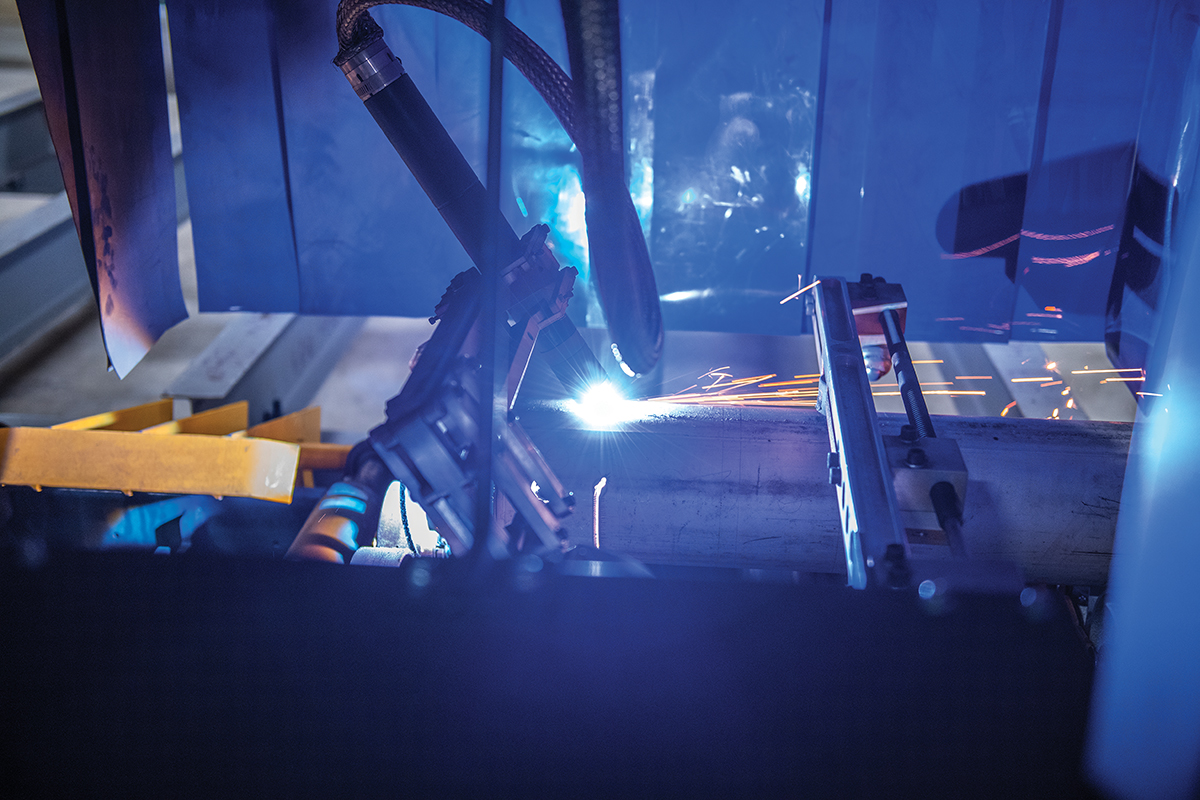

A Snapshot of the Metalworking and Fabrication Industry
The two largest sectors of the industry under the North American Industry Classification System (NAICS) are code 332, fabricated metal product manufacturing, and code 3335, metalworking machinery manufacturing. Together, there are more than 80,000 establishments and approximately 1.6 million people employed within these two sectors. This averages out to approximately 19 workers per establishment.
NAICS describes fabricated metal product manufacturing as industries that “transform metal into intermediate or end products, other than machinery, computers and electronics, and metal furniture, or treat metals and metal formed products fabricated elsewhere.” The two largest employee classifications within this sector are machinists and welders earning an average wage of $59,000 per year. Over the last five years, there has only been moderate wage growth of 10.3 percent, which is consistent with inflation. Interestingly, the employment within this sector peaked in the third quarter of 2019 and has been forecast to further decline over the coming years, likely due to increases in automation.
Metalworking machinery manufacturing is the industry classification for companies engaged in “metal cutting and metal forming machine tools; cutting tools; and accessories for metalworking machinery; special dies, tools, jigs and fixtures; industrial molds; rolling mill machinery; assembly machinery; coil handling, conversion, or straightening equipment; and wire drawing and fabricating machines.” While smaller than the fabricated metal product manufacturing sector with only 170,985 workers employed within the sector, metalworking machinery manufacturing is a $30 billion industry with an average wage of $62,653. This sector has declined over the last five years, namely due to downstream industry declines attributable to raw materials cost as well as the pandemic, but the sector has been forecast to grow moderately over the next five years.
In the coming years, the metalworking and fabrication industry will be affected greatly due to advancing technology, specifically automation, and workforce challenges caused by both the retirement of Baby Boomers and the increasing skill sets needed. Additional industry challenges will further stress this industry and determine who is able to adapt and grow. But with these challenges, there is also the opportunity for companies to embrace the changing times and flourish, or even for new companies to be established utilizing new technology.
Automation and Technology
Significant changes are occurring in the metalworking and fabrication industry due to advances in technology, especially automation. For example, robotics offers the advantages of faster project completion, higher part quality and process repeatability. However, there are both initial investment costs and ongoing operating costs associated with these technologies. A challenge for many companies, especially smaller establishments, is that the upfront costs to purchase and program new equipment can be cost-prohibitive. Implementation of new technologies also calls for additional training for the existing workforce. Facility layouts may also need to be modified due to the special footprints required for safety around robotic work cells. Once the new technologies have been implemented, recurring costs are likely to include increased wages for higher-skilled operators and maintenance mechanics, as well as future programming costs (which could be outsourced or might warrant new personnel for programming to be conducted internally).
Another technology that is evolving the metalworking and fabrication industry is 3D printing, or additive manufacturing (AM). The benefits of AM include rapid prototype creation and an expedited iterative design process, which have resulted in quicker speed-to-market with increased opportunity for enhanced product design. What once took three to four weeks can now be completed in three to four days. The technology is well-suited for specialized single-part projects or small-scale orders. Additionally, AM enables the creation of complex geometries which previously could not be achieved with traditional casting or machining processes.
Workforce
The metalworking and fabrication industry historically required a specific skill set that was manual and labor-intensive. The rise of computer numerical control (CNC) machining in the 1990s ushered in the need for additional skill sets in the industry. The modern machinist now benefits from CAM programming knowledge. In recent years, the industry has experienced only moderate wage growth with most increases just keeping up with the inflation rate. The current average wage for the industry is around $60,000, but the industry average may see more substantial increases over the coming years as a result of the more advanced skill sets that will be required due to advances in technology.
Manufacturers in a variety of industries, including metalworking and fabrication, need to be preparing for the challenges associated with an aging workforce that will retire in large numbers in the coming years. As the older generation exits the workforce, employers will be losing process knowledge and skill sets, but also the leadership and mentoring that these older workers provide. Therefore, it will be a pivotal time for the industry.
Communities that want to be equipped for the transition to the new workforce should evaluate the various existing programs in place to help train future employees with input from industry leaders. Many high schools across the country have implemented career academies that are geared toward science, technology, engineering and mathematics (STEM) and advanced manufacturing technologies, and others have placed increased emphasis on existing programs focused on trades which often include welding or machining programs. In addition, most community colleges or technical schools have at least one program focused on metalworking and fabrication, and many have programs created in partnership with existing industries for customized training or internships.
Collaboration between educational institutions and industry (from K-12 education through research universities) will be key for communities that wish to remain competitive as manufacturing continues to evolve. Apprenticeship programs have also been extremely successful for the metalworking and fabrication industry, and in some locations, there are even incentives available for establishing these programs.
Additional Industry Impacts
Over the last few years, there has been substantial volatility in raw materials costs, which poses significant challenges for pricing and forecasting. Additionally, historical difficulties in verifying material composition and origin have been further complicated by the need to source powdered metals for additive manufacturing.
Quality is key within the fabricated metal product manufacturing industry, especially when the parts produced are used in highly sensitive applications. The increase in complex AM has brought about changes in how parts are tested for quality. Computer tomography (CT) analysis is a growing method for quality inspection but requires specialized equipment and highly trained personnel (both to develop the inspection techniques and to interpret the results). For many companies, outsourcing testing to third-party labs is the best solution for accessing advanced testing capabilities. However, the availability of third-party labs that have advanced non-destructing techniques is limited. If testing capabilities are not available locally, a company may need to ship parts to a lab in another location, which increases costs and decreases speed-to-market.
Outside factors such as global competition and changing government regulations have also had an impact on the industry, and it remains to be seen how these factors will play out in the future. Accommodating for these outside factors is a constant challenge for companies trying to innovate and keep their workforce up to speed while also producing a quality product at a competitive cost.
New Players in the Industry
While there are challenges in the industry, there are also opportunities. New companies are taking advantage of the changing environment and technologies. One such company is INfab Piping Services, a new pipe fabrication company that was launched in 2020. INfab utilizes automated cutting and robotic welding to optimize quality, on-time performance (OTP) and cost. Serving the industrial market in industries such as wastewater, pulp and paper, and power, INfab can provide a high-quality product at a much faster rate than traditional piping fabrication processes. Human error is significantly reduced through robotic welding, which yields higher first-time quality and a low rejection rate. Additionally, by connecting their 3D models to their plasma cutting machine, complex cuts are up to 400 percent faster than the traditional measure, mark, cut, and bevel processes. Another benefit of using automation technology is that INfab can maintain consistent employment levels with less contract labor compared to traditional players. In addition to the robotic equipment, INfab has invested in technology that delivers data to their customers on job status, enhancing accountability and reliability.
Site Selection
For companies creating a new operation or expanding an existing operation in the metalworking and fabrication industry, there are a few key considerations to the site selection process. First, ensure that the utility capacities can meet the industry demands, specifically around electricity. The machinery for this industry is complex and requires stable electricity. Since electricity is a key component, electric costs should be evaluated during the process as they can vary drastically from location to location.
As discussed previously, availability of a skilled workforce is a challenge with this industry, so understanding the local workforce is key when looking to invest or expand in a community. While a full workforce analysis should be completed, the available skill sets should be a primary consideration when looking to locate in a community. After it has been determined that a community has the desired skill sets available, a wage evaluation should be undertaken to understand the existing wage environment as well as wage pressure that would forecast future wage growth. An additional consideration should be available training programs for both new and existing employees. If a community has an adequately skilled workforce with a competitive wage rate, then the available training programs could be the factor that secures the project investment.
When a company is determining where to make capital investments, evaluating the proximity to raw material suppliers and end customers is an important consideration as it impacts transportation and logistics costs. A shift in location of just a few hundred miles can often create drastic cost variance. The proximity to support services should also be evaluated thoroughly. There could be a big disruption to a business if maintenance technicians are not readily available if a machine goes down. Similarly, if a testing lab is needed for the product(s) being manufactured, then the proximity to testing labs should factor into the location decision.
Incentives are also a consideration for companies investing capital or creating new jobs and can come into play in a variety of ways. First, the cost of purchasing advanced manufacturing equipment will often meet the minimum capital investment threshold for incentives in many communities, which can account for substantial cost savings over a period of years. Depending on the new electricity load, there may be an opportunity for rate riders that would reduce electric costs over a period of years. Another key area for incentives is workforce training opportunities, both for new workers as well as upgrading existing workers’ skills. To capitalize on maximum incentives, it is crucial that incentive negotiations occur before any final decisions are made. Additionally, expedited permitting is an incentive that can be valuable when building a new facility, expanding an existing facility, or even for renovations within an existing facility footprint to accommodate robotic work cells or other advanced equipment.
Looking Forward
With the current changes in the industry, specifically around technology and workforce, the time for companies to grow and flourish is now if they are willing to invest in both their equipment and their employees. For communities, there is an opportunity to reach out to current companies in the metalworking and fabrication sector to see what help they require to grow and prosper. T&ID

